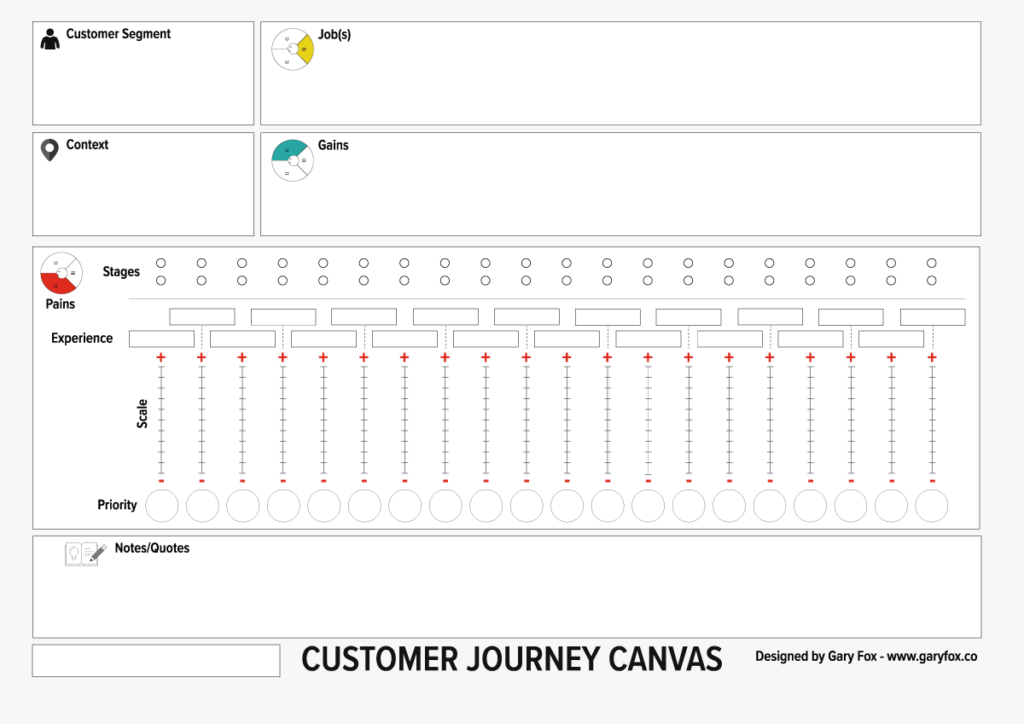The Customer Journey Map Canvas is a simple way to research and map the goals, gains and pains of the customer journey.
The canvas links to the Value Proposition canvas created by Alexander Osterwalder and Yves Pigneur.
At the bottom of this article, please share your thoughts and suggest any improvements that may be relevant for your industry/market/customers.
The two most powerful concepts in business today are business modelling and customer experience design. The customer journey canvas ties these two together and helps to unite your ideas and work.
If you’re looking for a regular Customer Journey Map Canvas – see the one at the bottom of the page.
Table of Contents
Why Use A Customer Journey Map?
The goal when using the Customer Journey Map Canvas is to map and prioritize the pains. These represent the greatest opportunities to explore how you can innovate – either adapt an existing product or service or completely reinvent how you can add value to the customer.
The Customer Journey Map Canvas provides an opportunity to capture the quotes and human expressions from real customers during your research. It is a simple and easy to understand method to explore the development of the value and neatly links to both the Value Proposition Canvas and the Growth Marketing Canvas.
Journey mapping is still a well-known tool in the field. One key characteristic of the design approach is the emphasis on iteration – starting with small, low-cost attempts and adapting the process along the way.
What Is A Customer Journey Map?
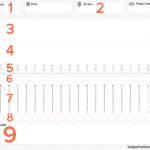
A customer journey map is a research tool that helps identify opportunities to improve the customer experience by mapping touchpoints.
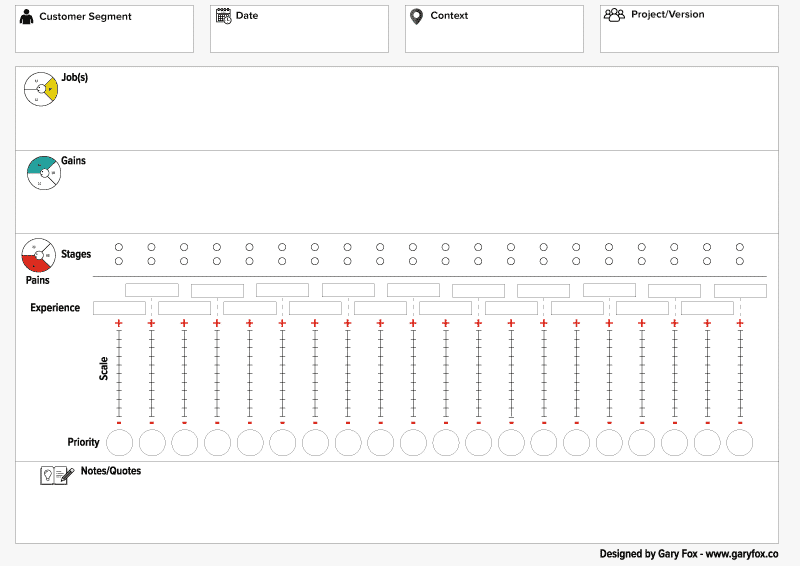
Customers who have poor and inconsistent experiences with products and services get frustrated. However, internally companies don’t even notice or consider these frustrations. Why?
Usually, companies are focused on internal optimizations rather than on external customer-focused innovations. Too often I find they have their focus on trying to deliver a big digital transformation programme. From my work, I have seen teams with the best intentions too focused on internal processes.
Many simply don’t know what customers actually go through. They also miss out on spotting new customer segments they could serve as they watch and observe real customers in real situations.
Innovation isn’t easy and requires a consistent focus on customers. It demands moving beyond the thrill of generating interesting ideas and moving into the area of taking risks and testing new ideas with customers. Many companies simply risk-averse and think that as long as they are hitting their numbers (or maintaining them) that everything is ok.
However, while they are focusing on these change programmes more agile and customer-focused companies come up with simple solutions to customers goals and problems.
Clayton Christensen highlights in his work how these companies encroach on the established players and progressively steal their customers. New and more innovative solutions now abound. The rapid pace of technology provides countless ways to innovate and create new products and services that add value to customers.
You only have to look at how Fintech is changing the banking industry to realise that newcomers are progressively chipping away at the traditional business model of a bank.
The Customer Journey Map Canvas helps to map your customer’s experiences and those of your competitors.
Why Use A Customer Journey Map?
It isn’t just ‘design thinkers’ or ‘designers’ that can use the Customer Journey Canvas. Product and brand managers, marketers, and business owners can learn how Experience Mapping can help to meet common business goals.
There is a direct correlation between understanding your customer and designing your business.
Getting Past The Dominant Logic
Innovation is not what you innovators do… It is what customers and clients adopt.
The problem though is that companies often get caught into a dominant logic of how their business works, how it delivers value and how customers experience the delivery of value (products or services).
In times of change learners inherit the earth; while the learned find themselves beautifully equipped to deal with a world that no longer exists.
Eric Hoffer
Markets and customers change and as a result, the company become misaligned to the actual value and experiences. Furthermore, as services and products in a market advance so too does the expectations of customers.
The net result is that solutions are built that are detached from reality, there is a focus on technology rather than experience, and strategy is shortsighted.
Not Every Customer Segment Is The Same
If a customer is likely to spend $50 with your company, you can’t afford to provide a service that costs $50. That sounds simple right! Yet too often companies provide the same service to all their customers.
Different customer segments provide opportunities to serve and add value to them at a cost that is profitable. In other words, providing smart solutions that are cost-effective relative to a customer segment is critical.
How The Customer Journey Map Canvas Links To The Other Canvas Models
Companies that don’t identify new business opportunities will find themselves playing catch-up to some collection of startups, digital giants, savvy competitors, and aggressive outsiders that will redefine their industries.
Please note: I have put pains only in the box but people will have moments of delight as well as pains.
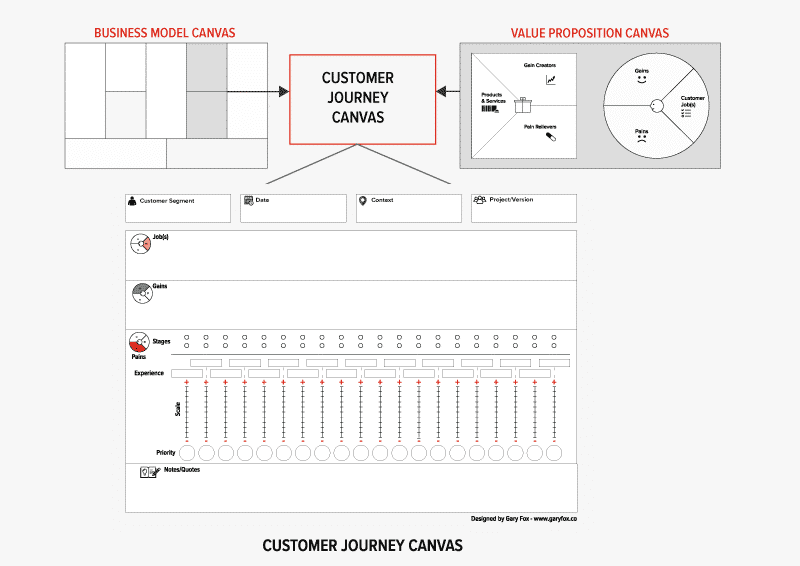
The benefit of using business modelling is how it shifts thinking within an organization. In particular;
- Reframe competition and opportunities for coopetition – how to create value with new partnerships.
- Create shared value – to create new value with customers and through a digital ecosystem.
- Reimagines value delivery – how to create new value and realise new opportunities.
- Organize to innovate – how to organize in new ways to fulfil new value propositions.
The Sections Of The Customer Journey Canvas Explained
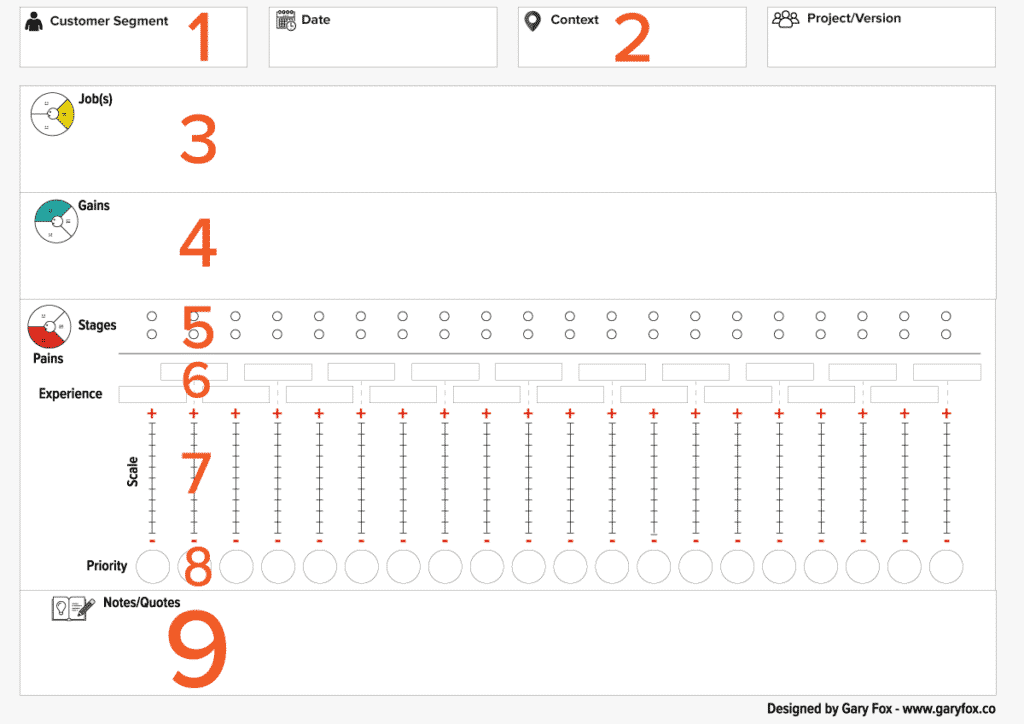
How To Use The Customer Journey Canvas – Step By Step Guide
1. Customer Segment
The most natural way to segment your customer initially is to use your existing data. If you’re a startup then you can use a host of other methods that I cover in my post on customer segmentation.
The principle is often a simple if you are in a B2B service because your customer will often be a person with a job – a relatable title and associated attributes that link them to a company e.g. size of company, sector, location, international vs. national…
For customer experience mapping it is important to at least have an idea of who your customers are. The idea behind this canvas is that you will harness your ideas and work from either the Business Model Canvas or the Lean Business Model Canvas.
2. Context
The customer journey is not about product research – this is a common mistake or lens that people look at the world. Your goal is to look at what individuals do, think, and feel in a given context.
The idea is to simply reveal touchpoints and the context of those touchpoints. Each context will have layers of information come together during an exchange of value.
Some considerations when planning the customer experience is the setting, environment, location and the touchpoints. A touchpoint is an interaction between an individual and an organization at a given time and within a given environment. The critical part of this is to analyse the circumstances and not just the customer.
As an example of a context, the same person can book and experience a restaurant as follows:
- as a meal out with the family
- as a romantic night out with their partner
- as an opportunity to catch-up with a friend
- as a place to meet a client.
In each case, their emotional state and expectation will differ.
- The meal out with the family might look for a restaurant to provide a choice of meal sizes.
- The romantic night out the table location becomes crucial.
- The catch-Up with a friend might mean a longer stay at the bar before the meal.
- The meeting with a client might call for prompt and efficient service and a good knowledge of wine by the waiter.
There are countless ways context becomes important for customers but too often is ignored.
3. Customer Job(s)

Jobs to be done is an existing framework that helps view value from an individual’s standpoint. Popularized by Clayton Christensen in his book ‘Competing Against Luck‘, the practice looks at why people “hire” products and services to reach the desired outcome.
A quick recap:
- Jobs to be done. These are the important issues people want solving and the needs they are trying to satisfy.
- Pains. These are the barriers, hurdles, and annoyances people have in trying to get a job done. This includes negative emotions and risks they may encounter.
- Gains. These are positive outcomes or benefits the individual desires.
The goal is to identify jobs with high importance that are unsatisfied.
- Conduct some primary research
- Create a model diagram – a. cluster findings and find themes. b. hold a workshop to enable team to collaborate on findings and identify goals. c. Score and prioritize opportunities = importance + satisfaction gap.
- Focus opportunities
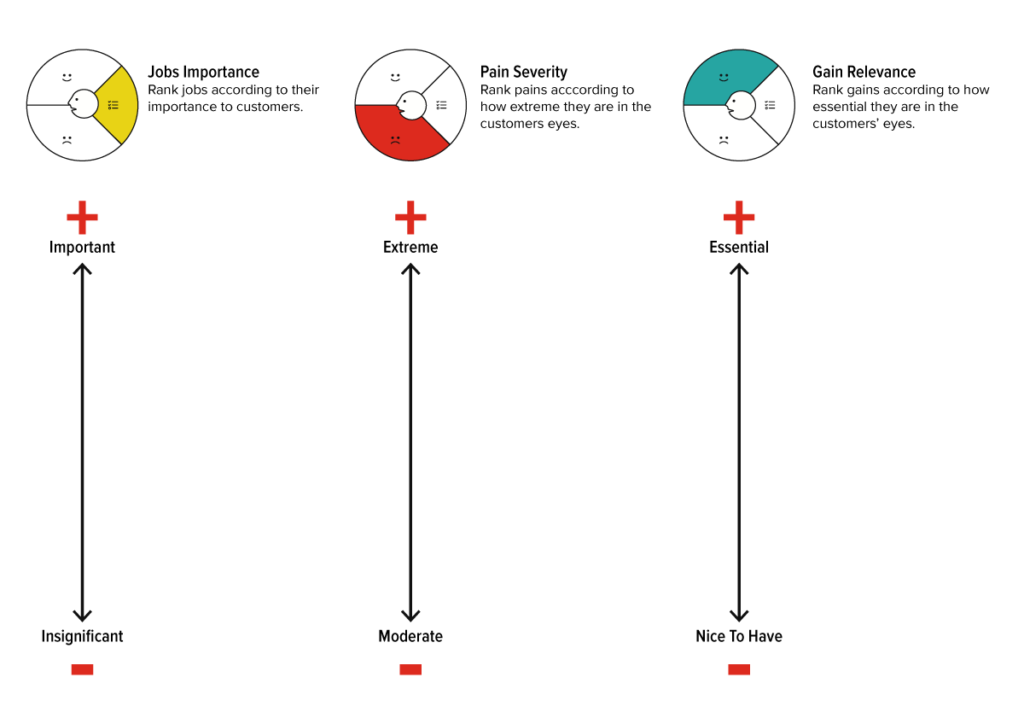
4. Customer Gains

The tendency is to move towards a logical view of the world. A lens in which you look for features and benefits and not motivations and desires.
Yet all the research shows that despite how much we like to think we make logical buying decisions, the fact is we don’t. Our experiences, emotions and motivations cloud our judgment. If you want to read more on this a good starting point is Predictably Irrational by Dan Ariely.
Where understanding gains simple snippets and comments can be used to help guide you. Of course, simply asking why is better. On the Customer Journey Canvas, you are simply looking to understand the gains not solve them at this stage – that is for later when developing your value proposition.
5. Customer Stages
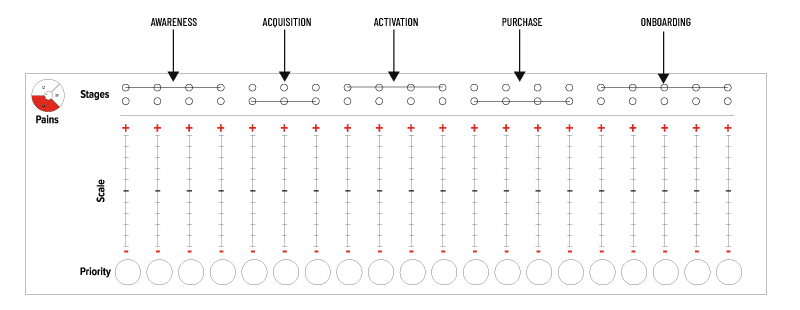
Customer experience maps will depend on the context. As a simple illustration, I’ve highlighted how you might label some stages based on a marketing funnel. The dots provide a way to connect and label stages that either exist naturally, or help you in terms of a mental concept, or fit to a process.
Some stages might simply consist of two experiences others may be much longer. If you need to go for longer experiences you can simply pin two Customer Journey Canvas’s side by side to help you – creating a 40 step map.
6. Experiences

Experiences are the labels for touchpoints and moments that create an emotional impact. Use these to allocate a simple, but easy to understand, name to each experience.
7. The Experience Scale
The scale is relative to each experience. This section records the impact of the experience. Taken as a journey it becomes easier to identify across the scale the moments that were positive vs negative.
8. Prioritizing The Outcomes
Not all experiences carry the same weight or importance, However, the importance can vary from individual to individual. So while there are some common themes you also need to ensure you have enough data to pick out the outliers.
Prioritizing the outcomes gives you the pains that you can then use to help with the scale on the Value Proposition Canvas – see section 3 earlier on using a Scale Canvas.
9. Notes/Quotes
Notes/Quotes are useful to capture comments and expressions used by customers. Often these can encapsulate more than any scale and give you a way to communicate the problems to others and in workshops.
Customer Journey Canvas Tips
- Human-centered: Consider the experience of all the people affected by the service.
- Collaborative: Stakeholders of various backgrounds and functions should be actively engaged in the service design process.
- Iterative: Service design is an exploratory, adaptive, and experimental approach, iterating toward implementation.
- Sequential: The service should be visualized and orchestrated as a sequence of interrelated actions.
- Real: Needs should be researched in reality, ideas prototyped in reality, and intangible values evidenced as physical or digital reality.
- Holistic: Services should sustainably address the needs of all stakeholders through the entire service and across the business.
Download The Customer Journey Canvas
Bonus
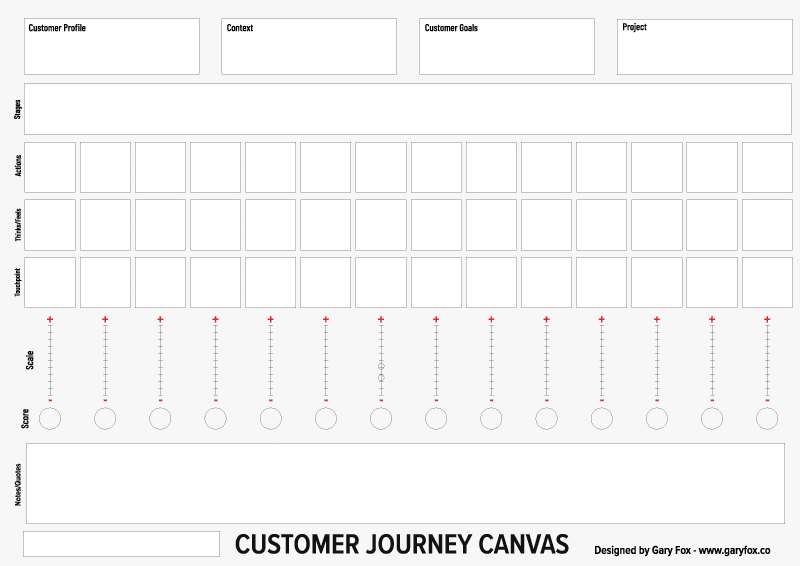
A few people have asked for a regular customer journey map templates in pdf format that they can use.
I’ve included these below.
